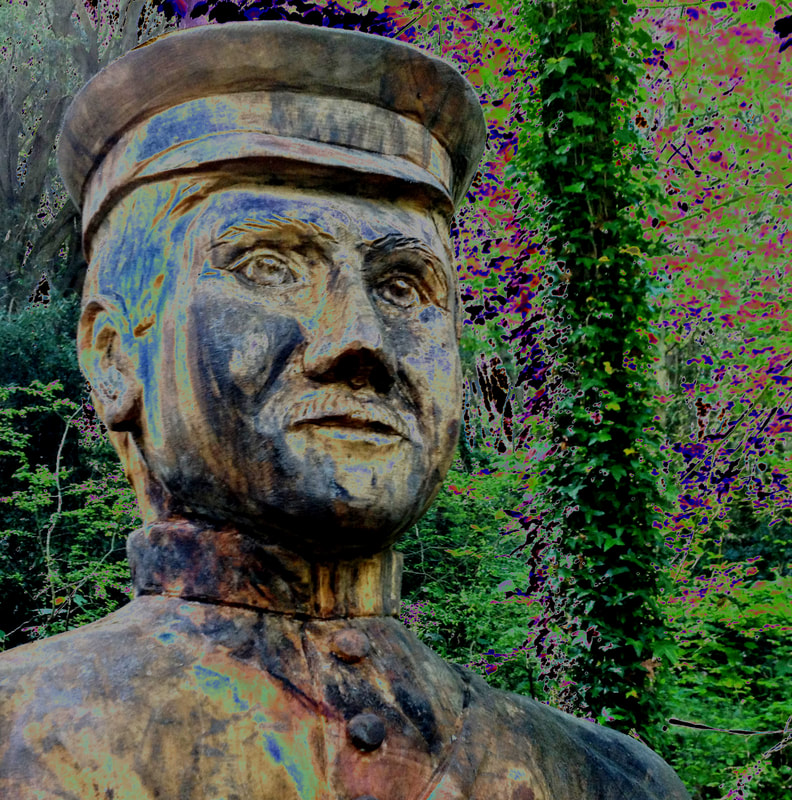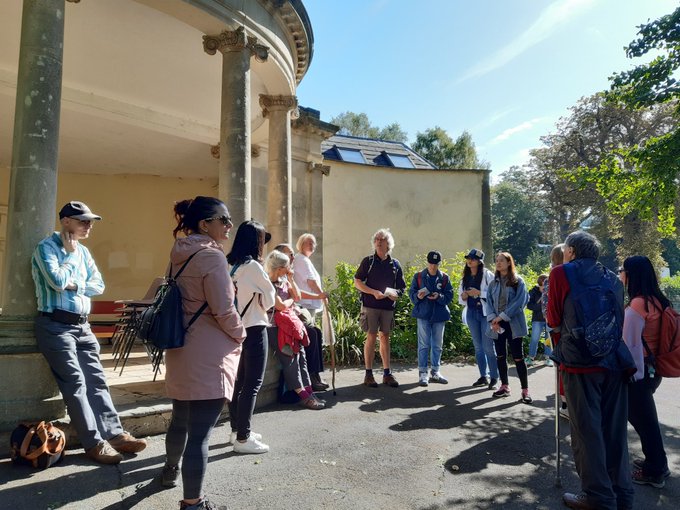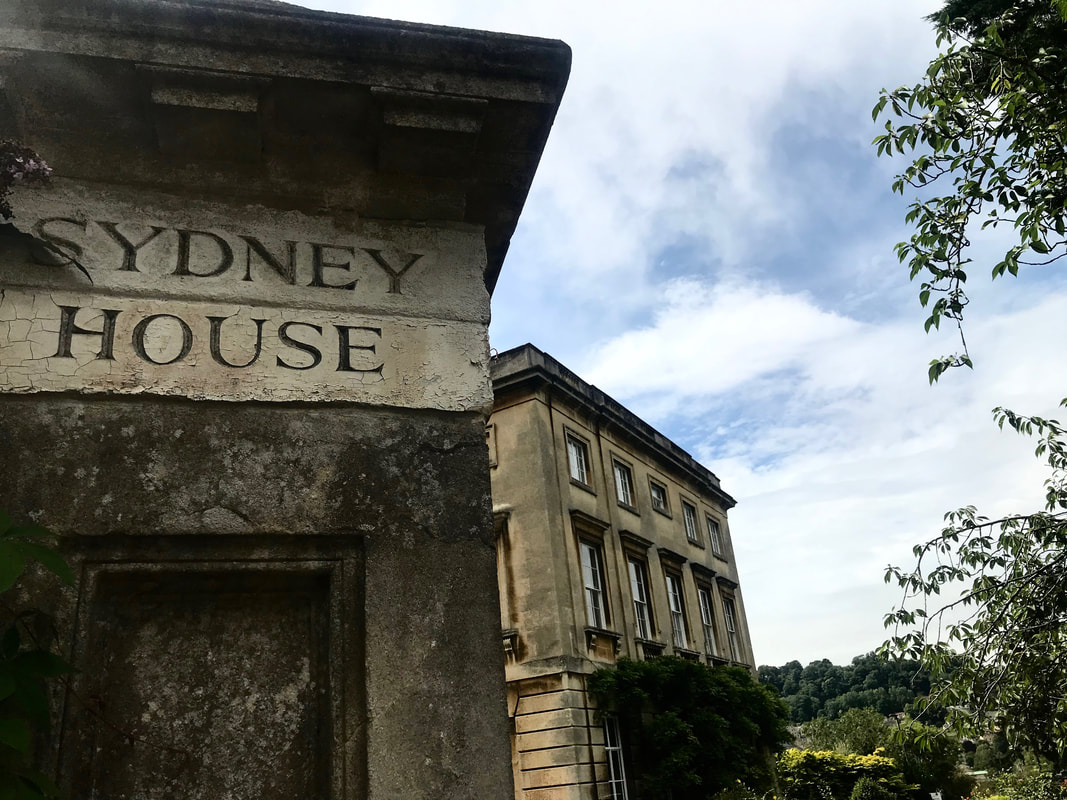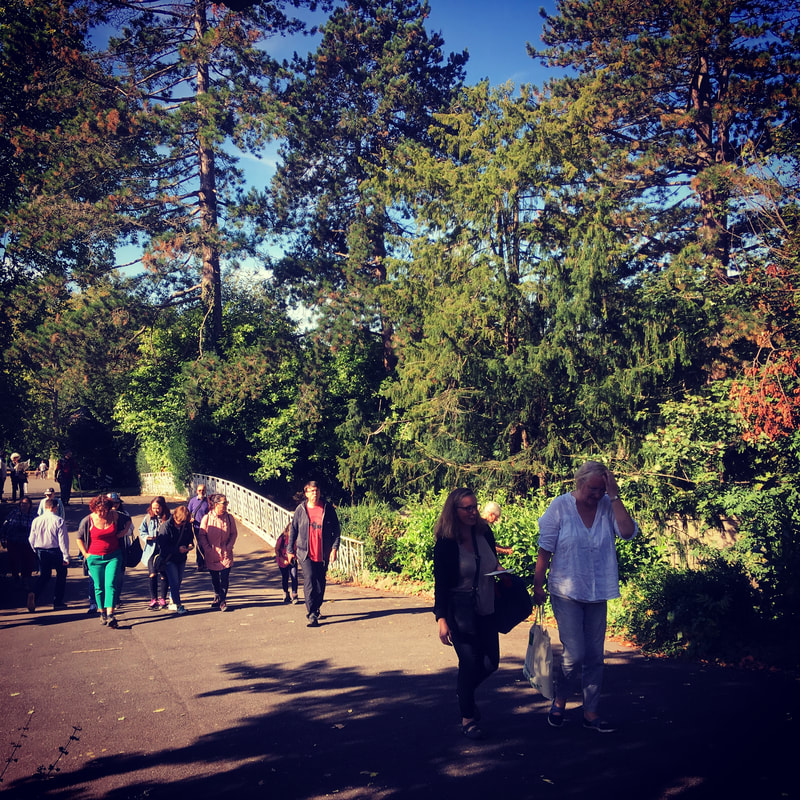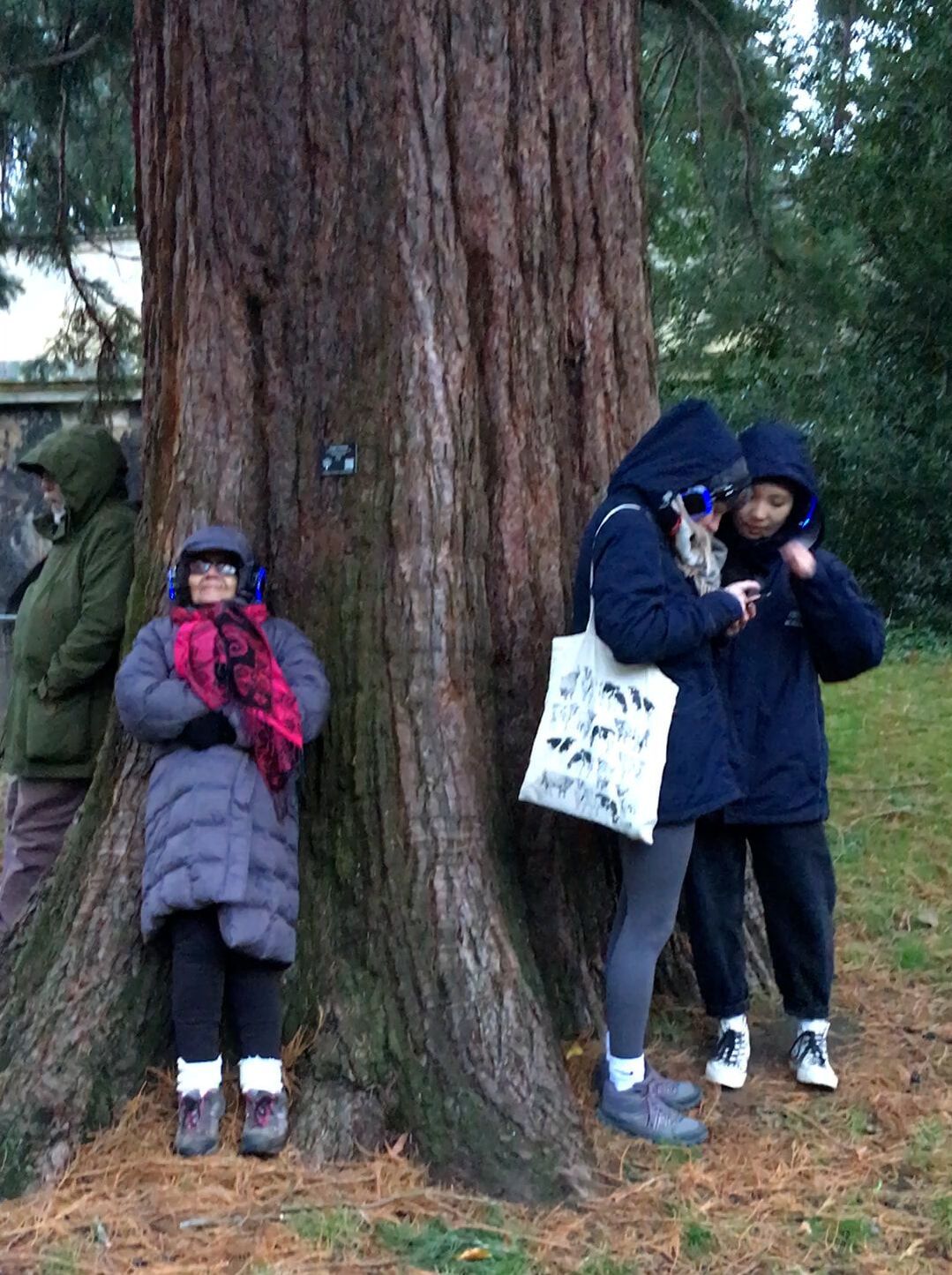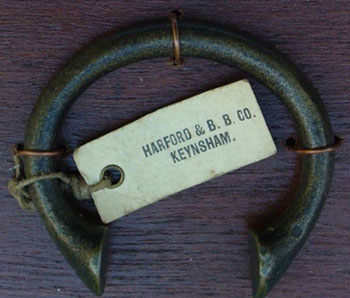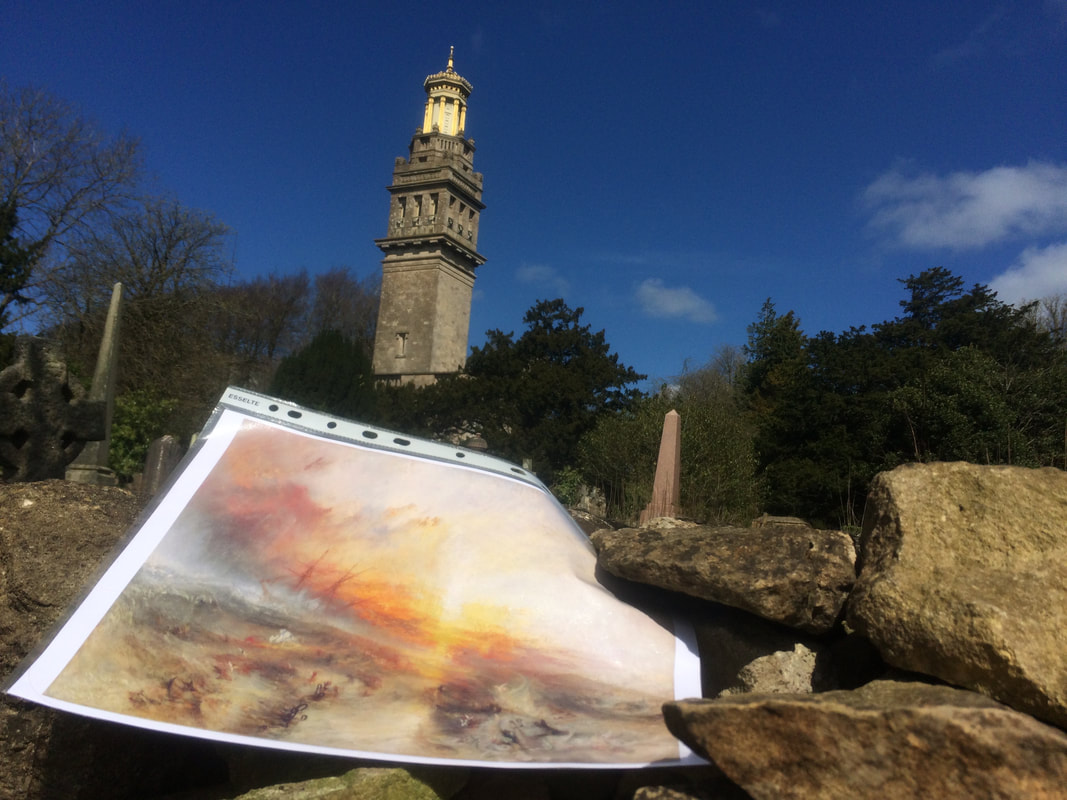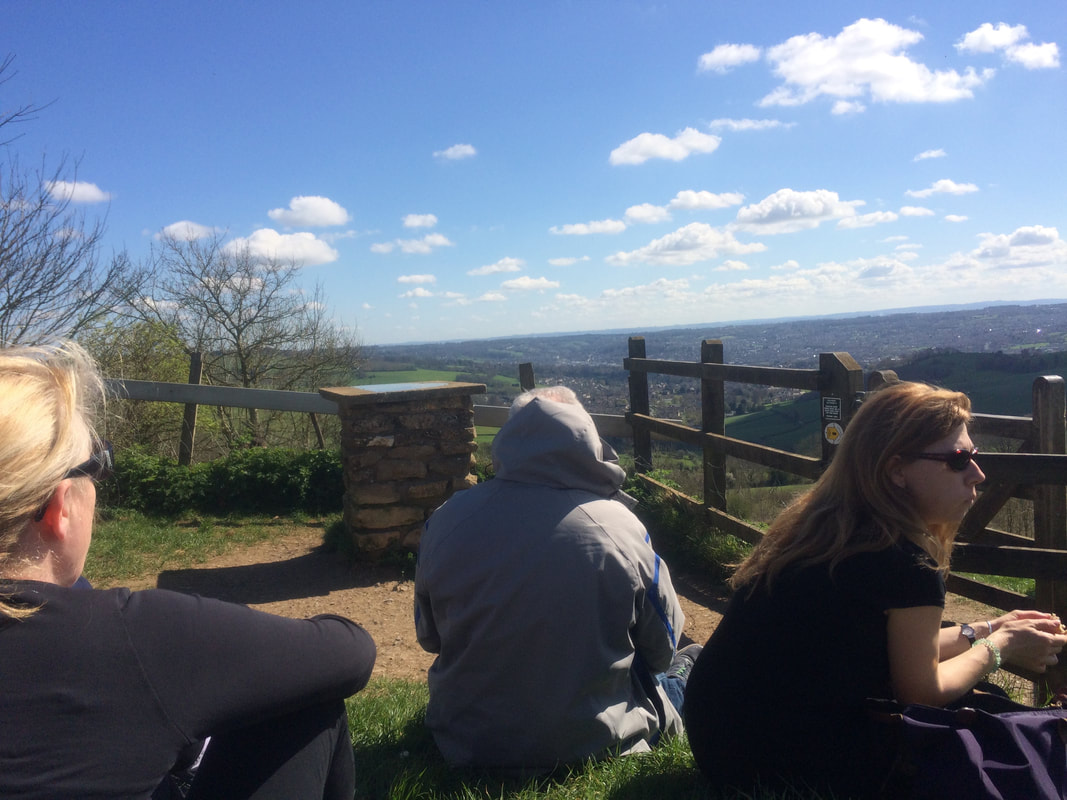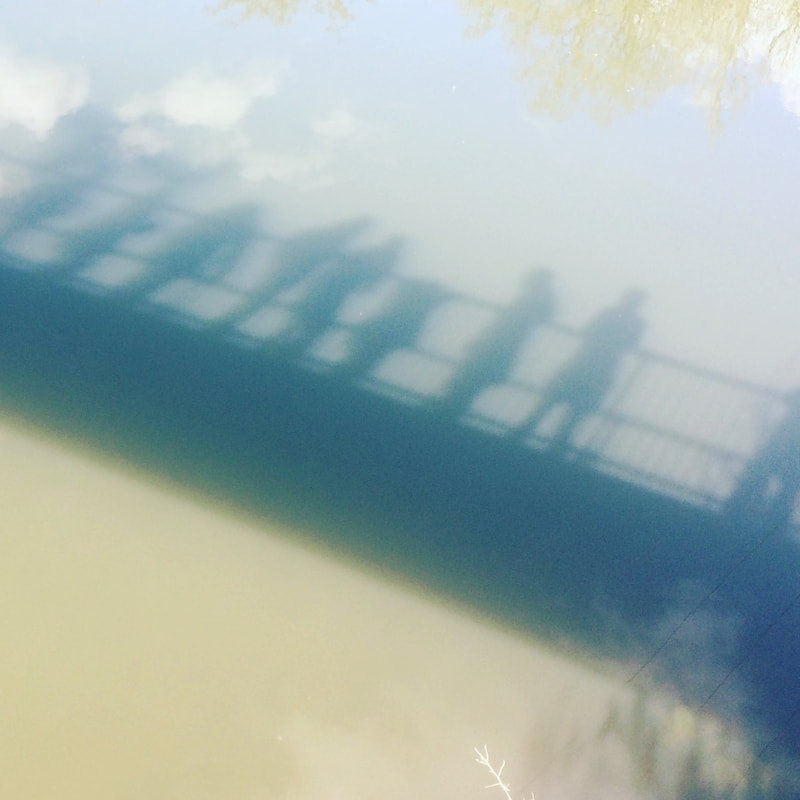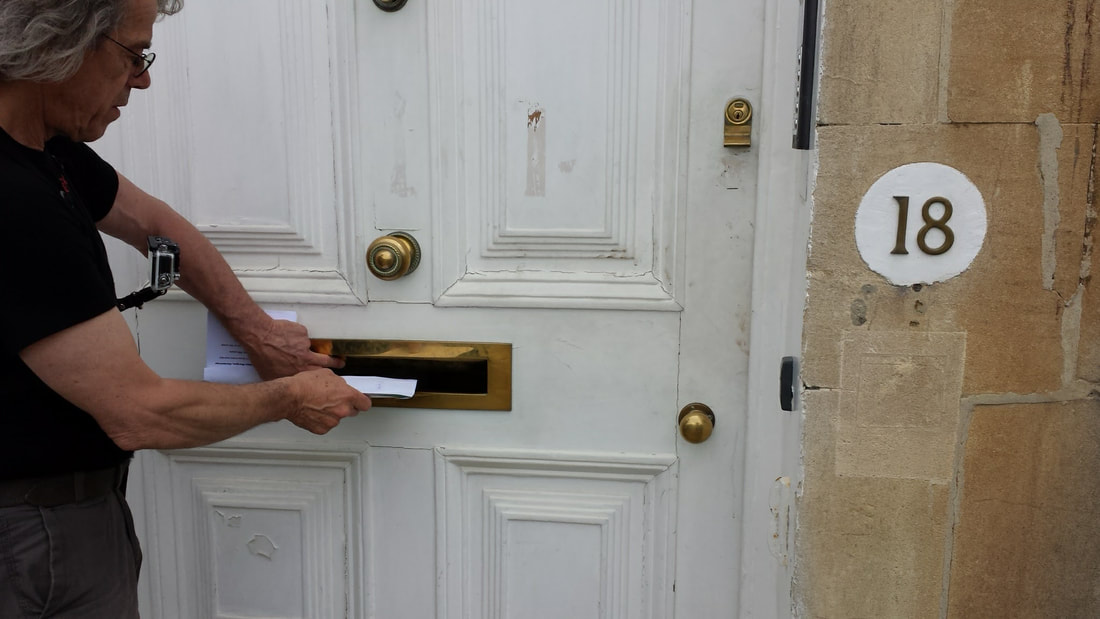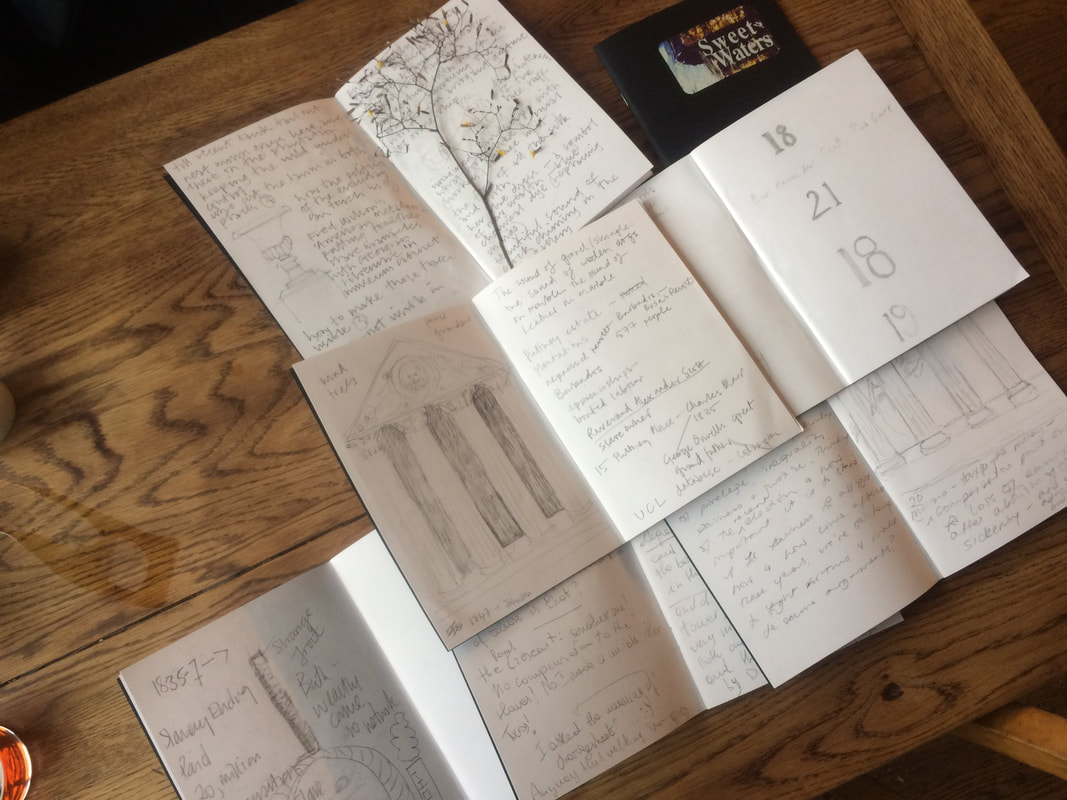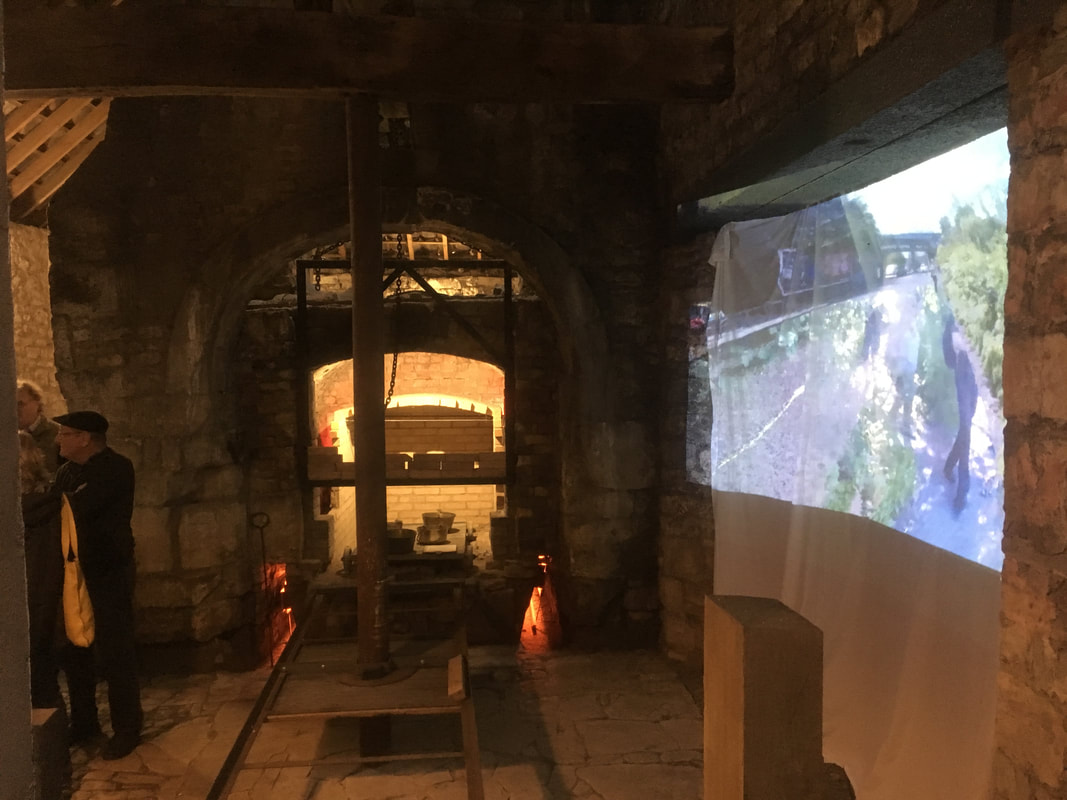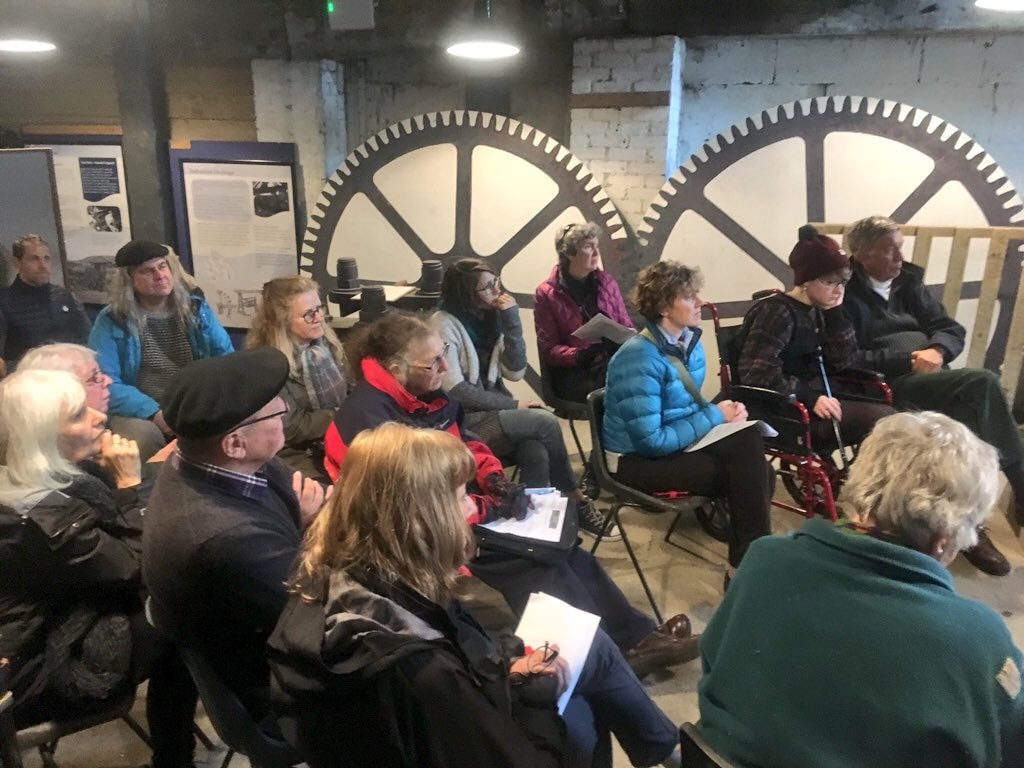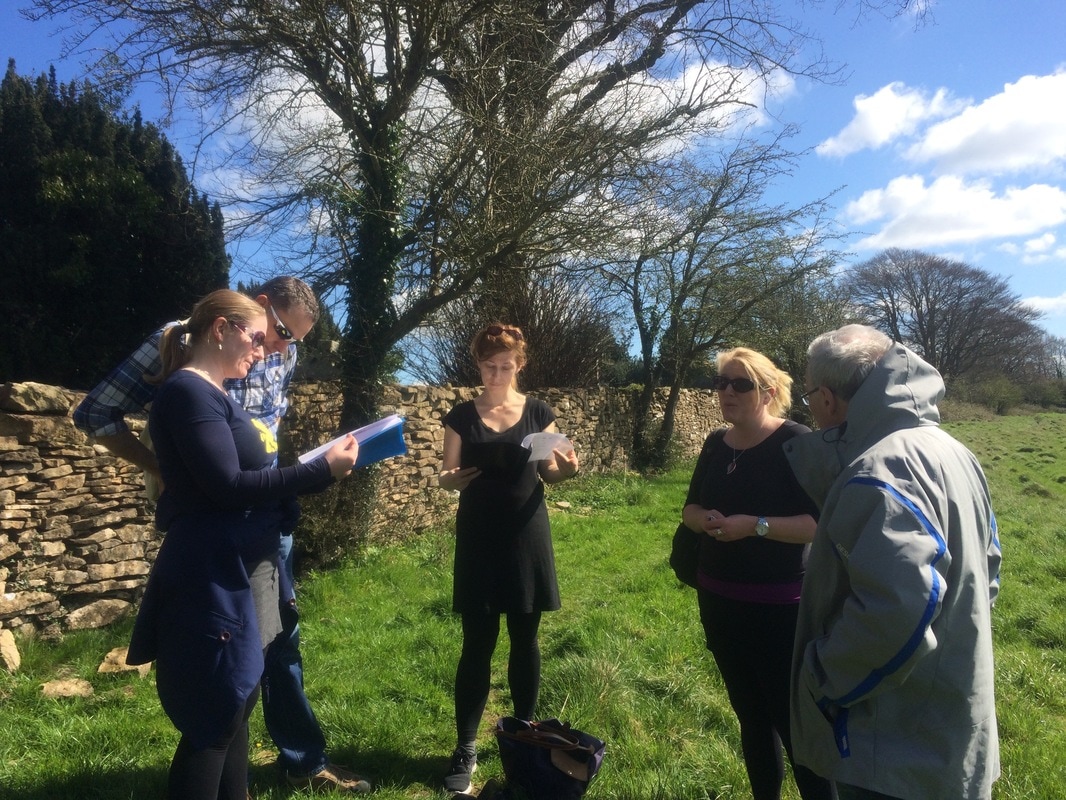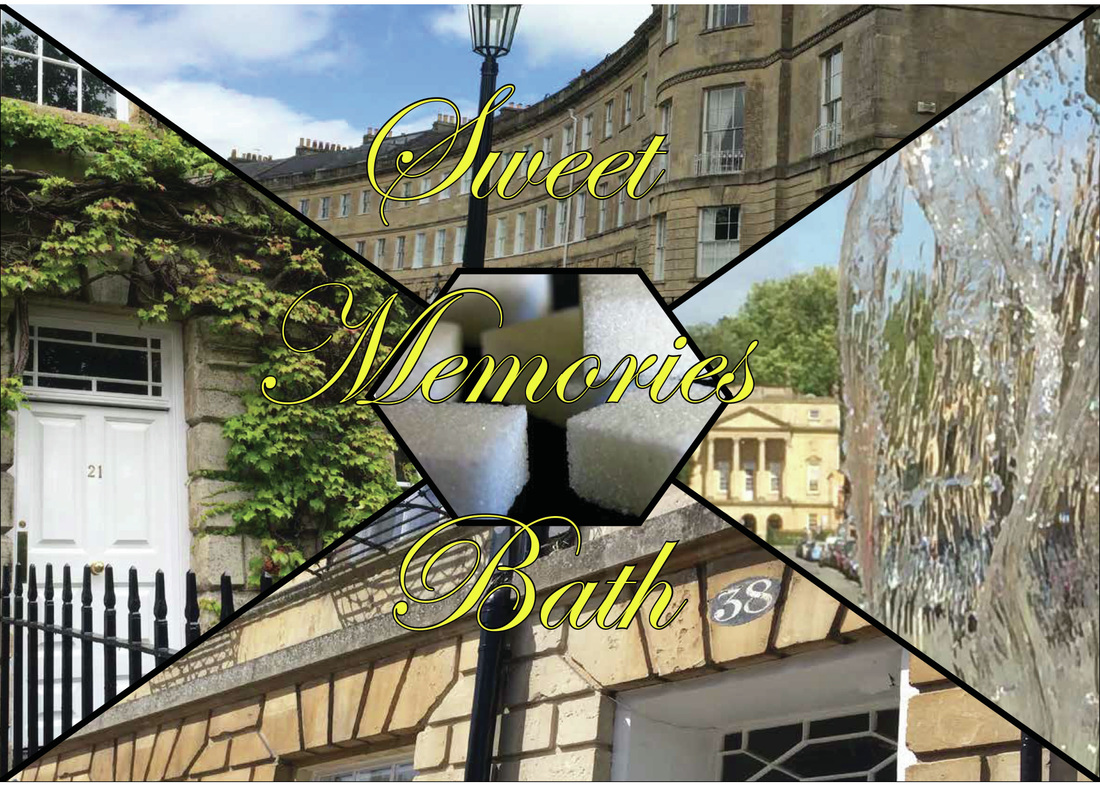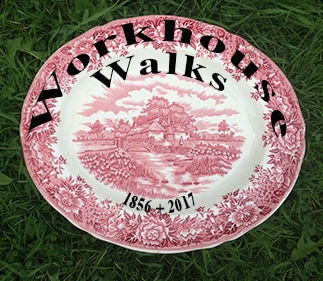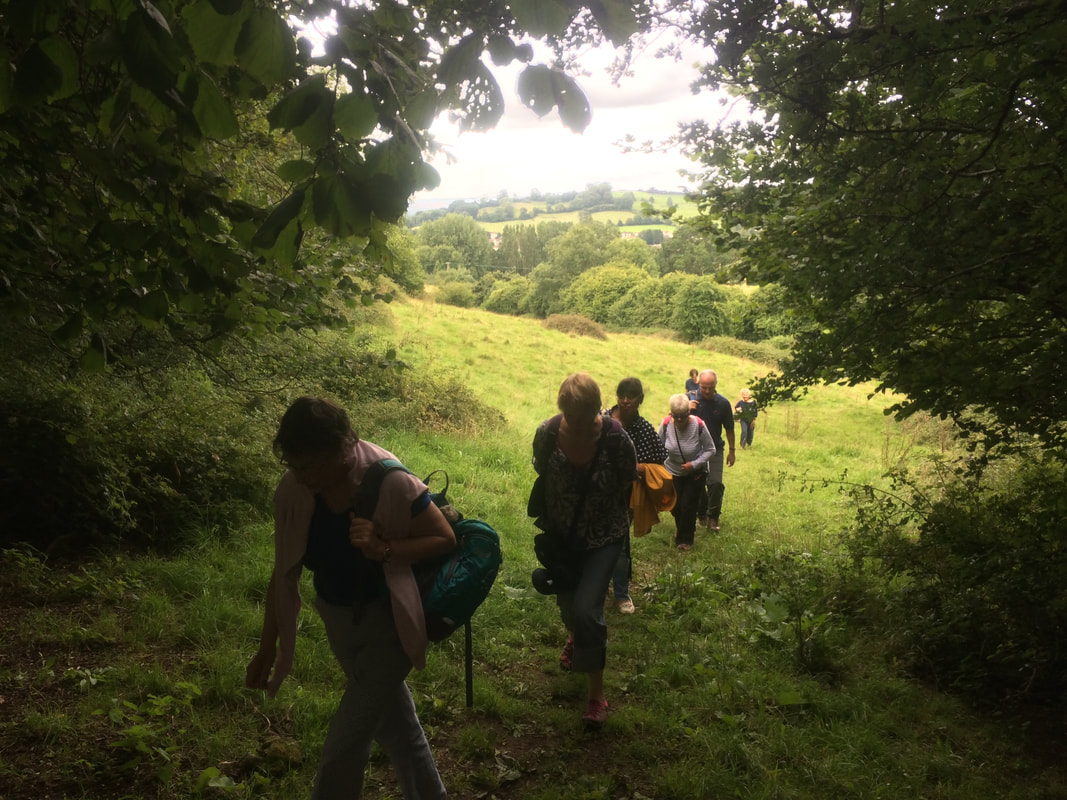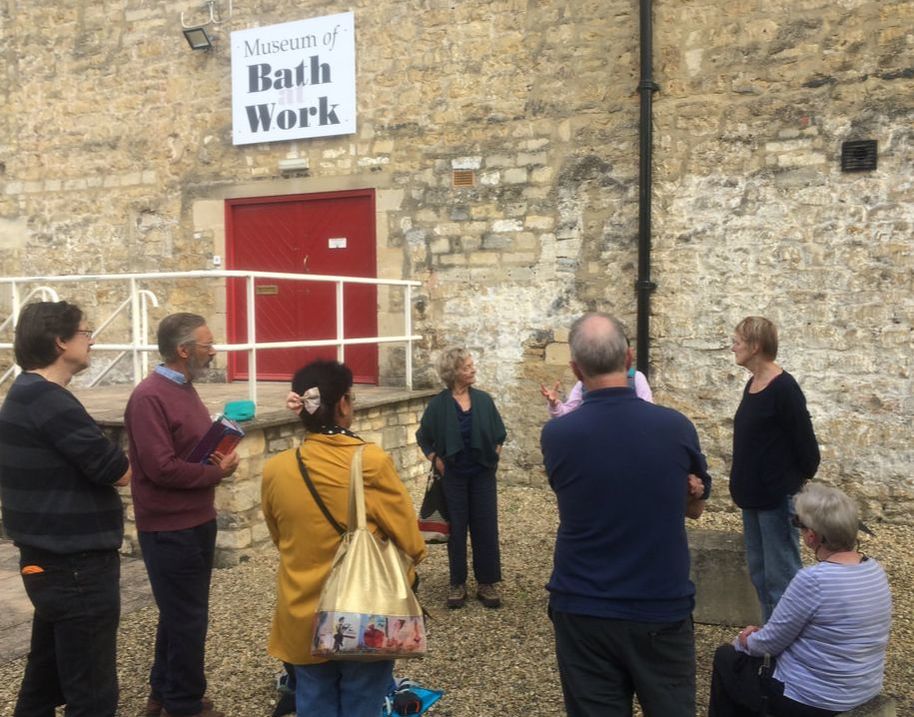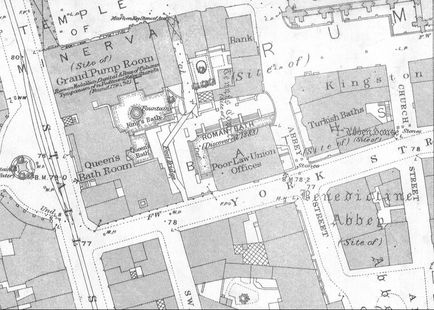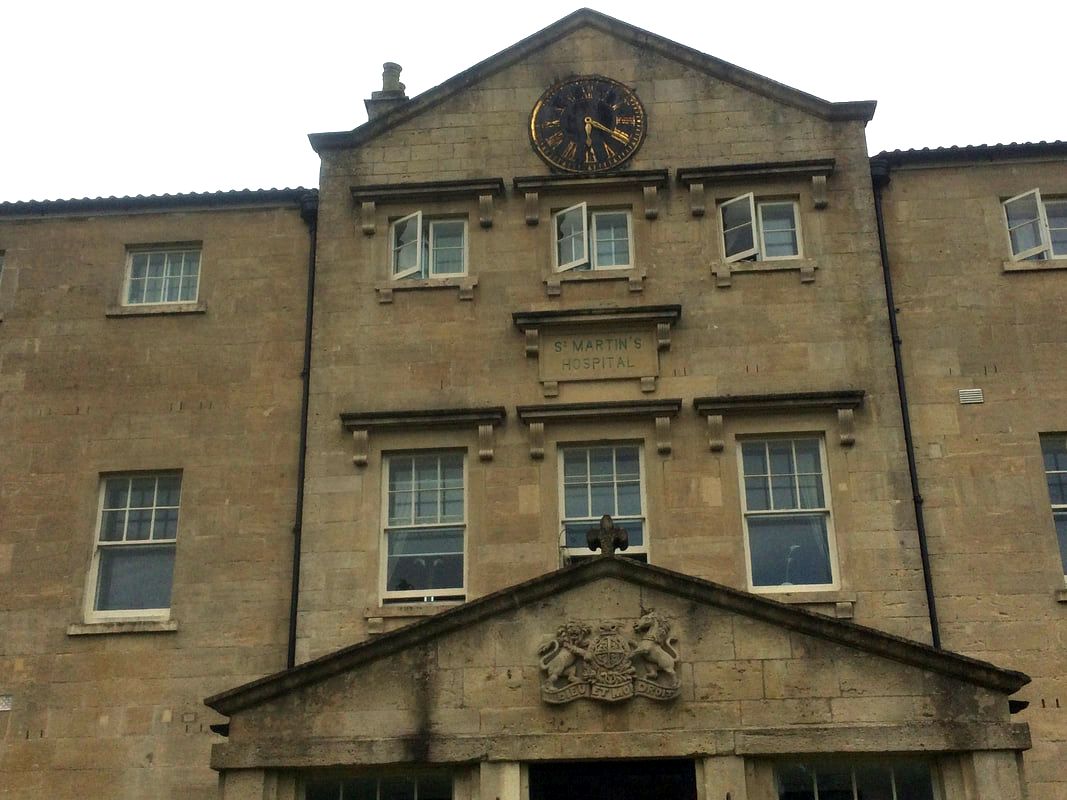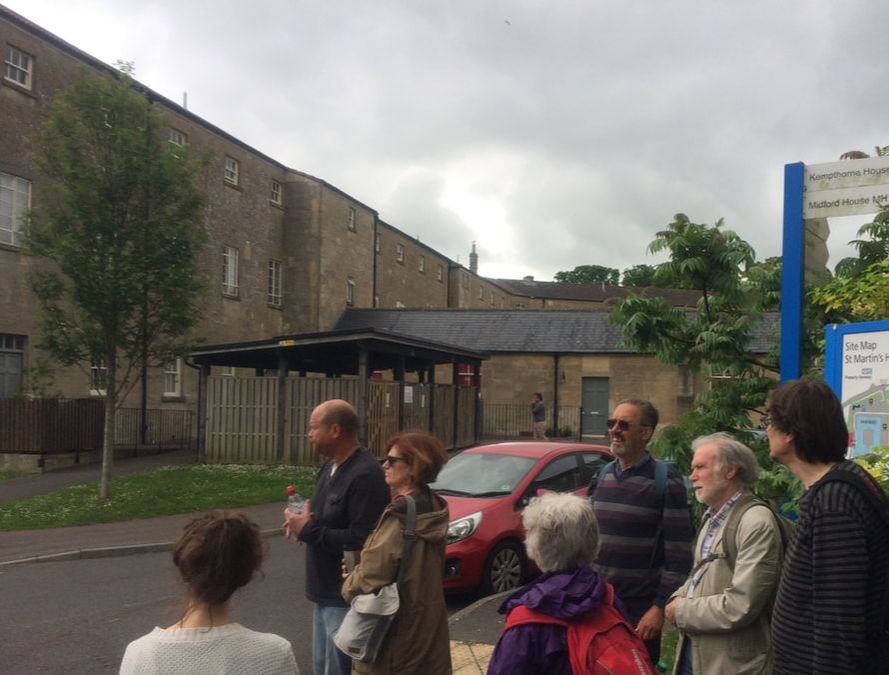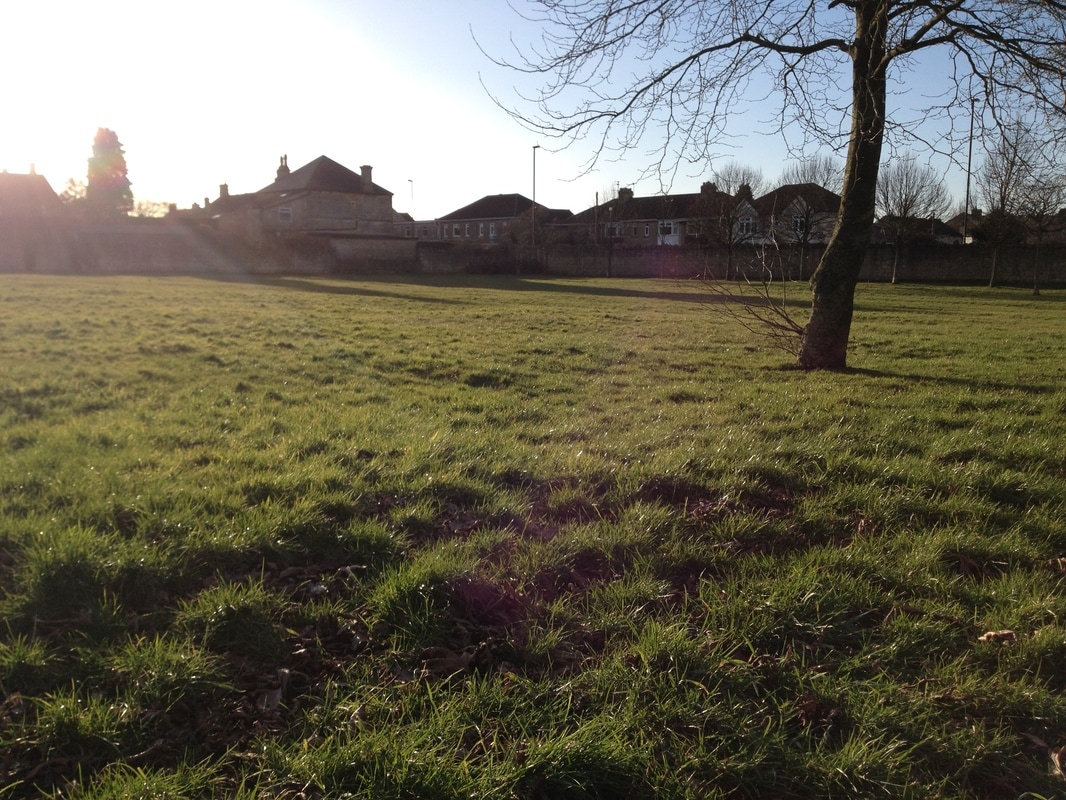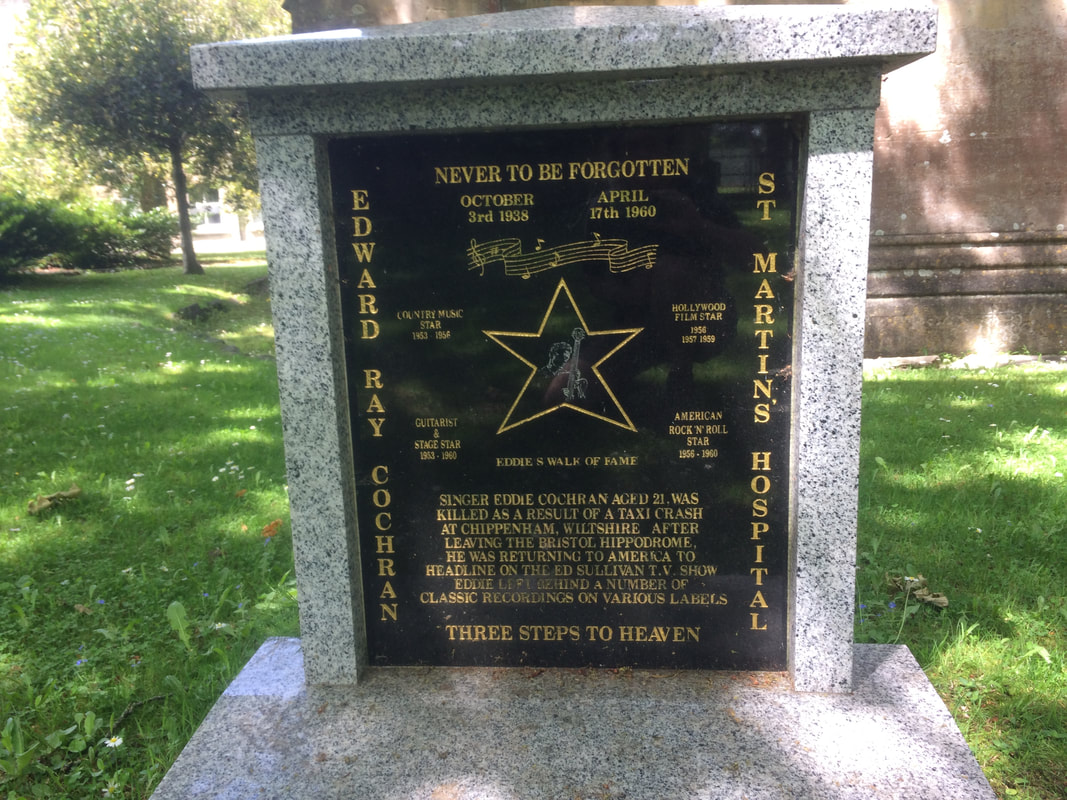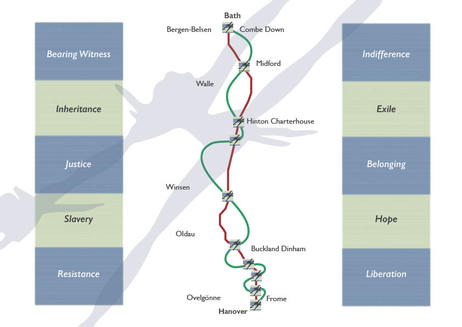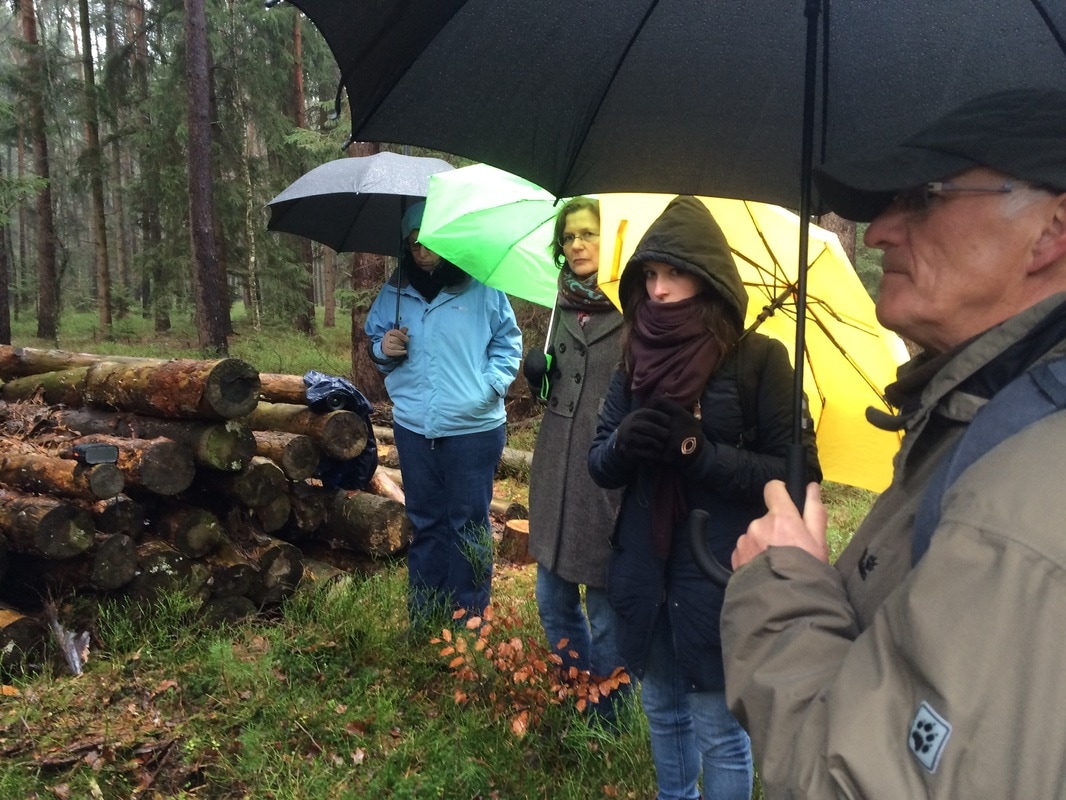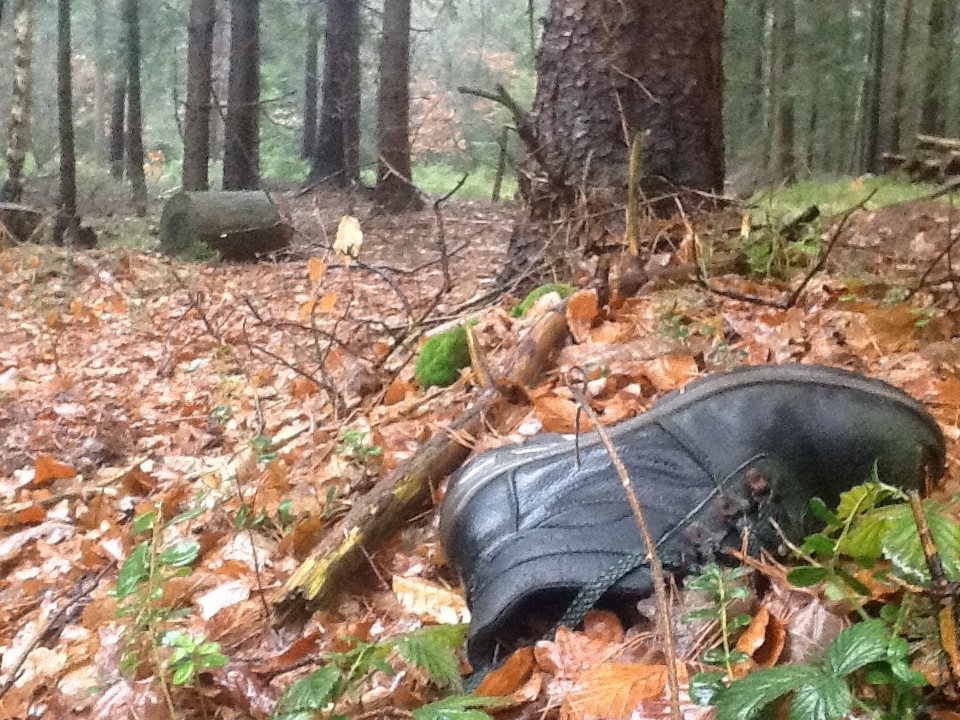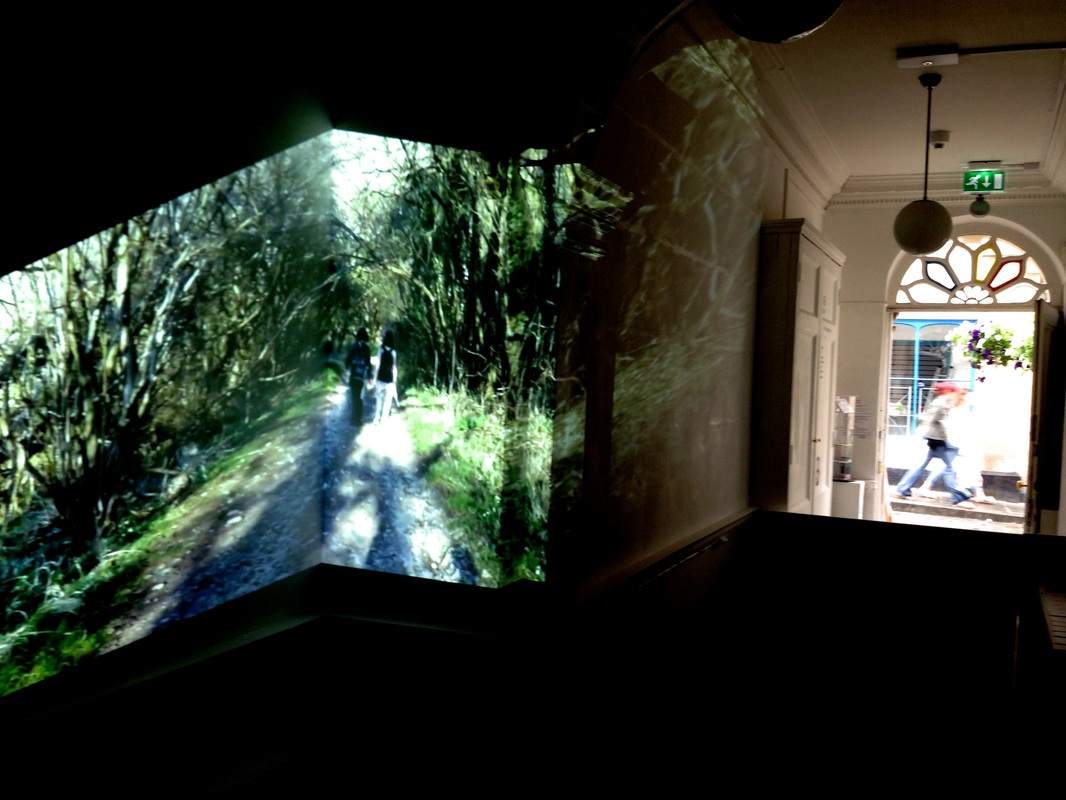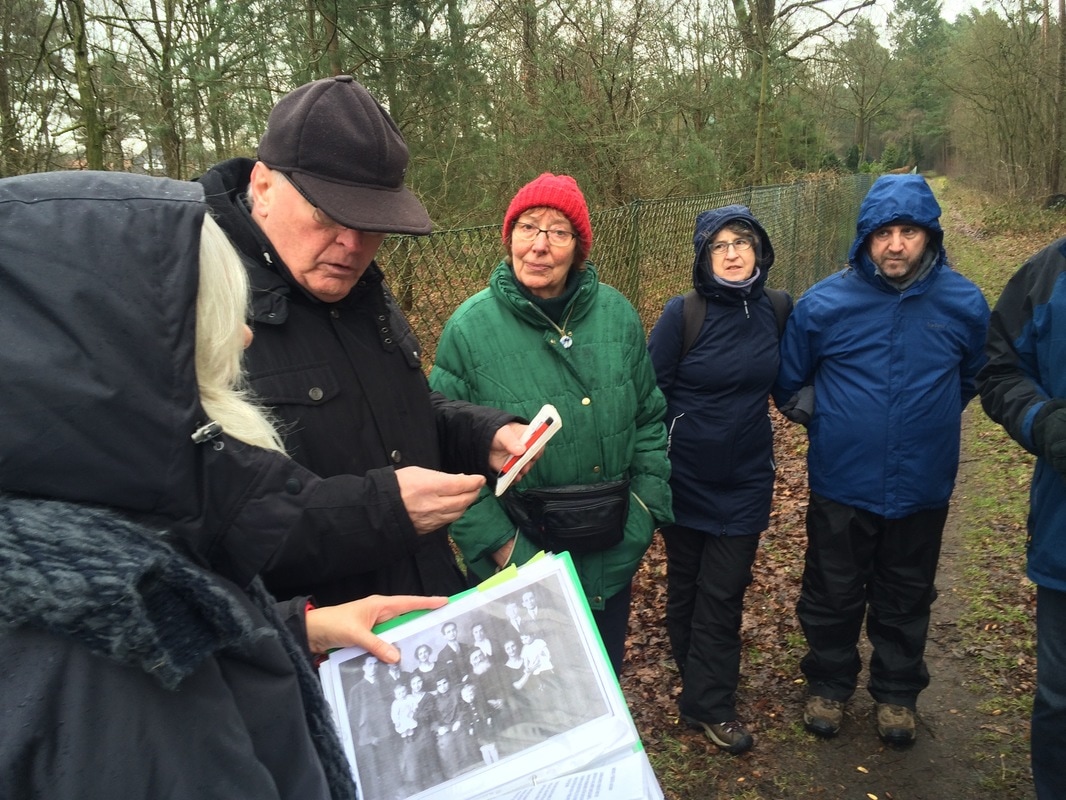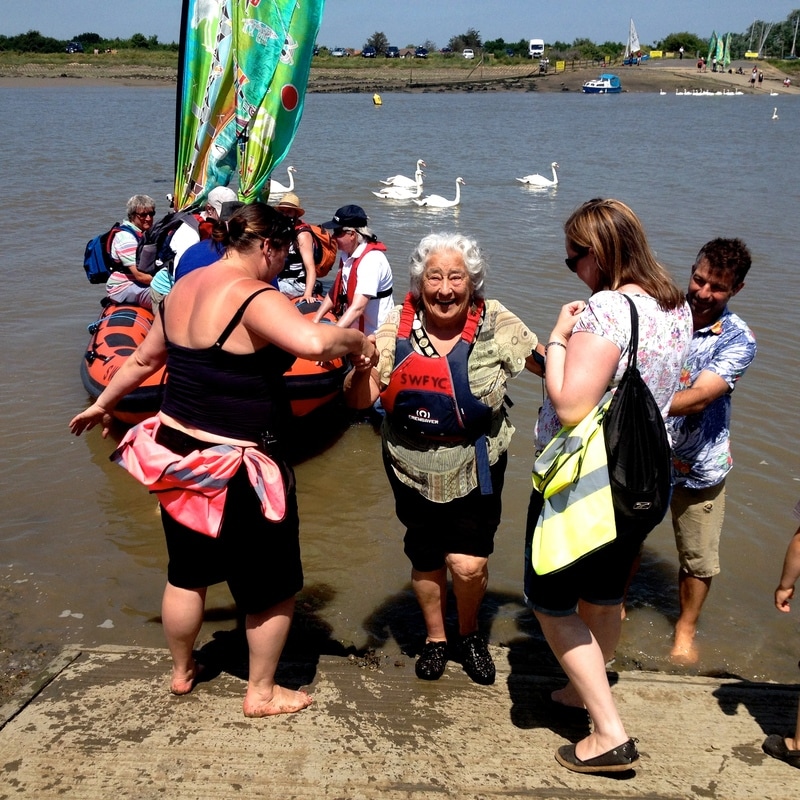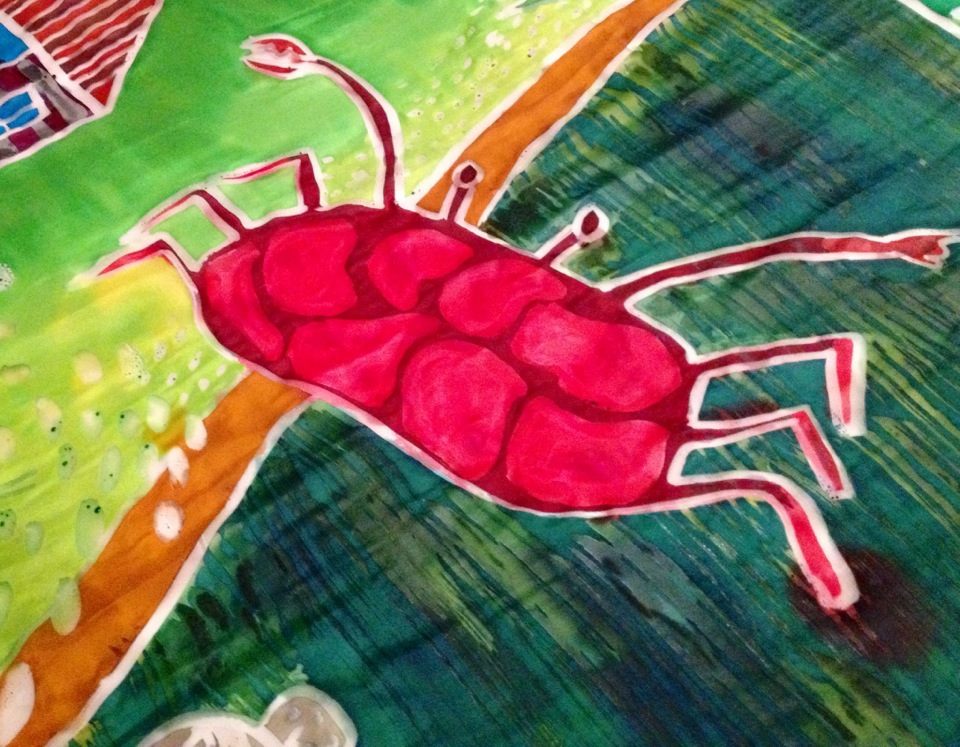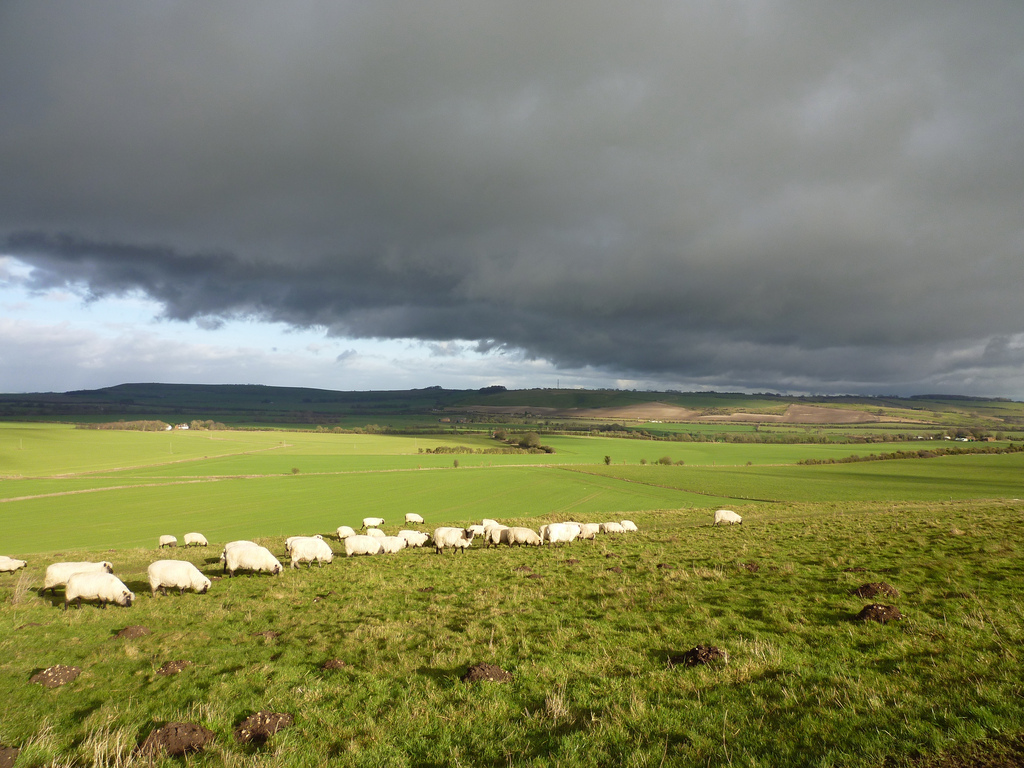An archive of walking since 2012.
|
|
Listen to an element of the sound walk presented in Sydney Gardens!
An invitation to be with a huge tree growing alone beside the railway line in Bath's Sydney Gardens. A meditation, some history and a gentle provocation on empire and climate change. Part of a cycle of work on botany, empire and deep time. This sound piece is a product of a collaboration with composer and soundartist Joseff Harris. |
Botany, Empire and Deep Time: a cycle of walking and asking questions in Bath's Sydney GardensA series of walks and commissions 2019-21 from a Lottery funded project that spanned the lockdowns and the worst of the covid pandemic.
As well as a series of public performative walks the commission generated three itineraries published on the Sydney Gardens blog. These will be re-published here in the future. In the meantime the links are below: 1) Sydney Gardens, a reluctant heritage.
A scene setting underneath two old Beech trees Perhaps you have just walked in past the Holburne Museum, maybe you had a cup of tea there, we’ll come to tea later. Once that was the only way into these Pleasure Gardens. Years ago it was a private space for subscribers only, surrounded by seven foot high walls and a track for horse riding. Perhaps you came in from the where the new gate once stood; a small kiosk remains as a memory of a ticket price. The gardens are now free to enter, although of course we pay for them through our rates and are thankful for the money that recently flowed in from those who play the National Lottery. As in all things there is a price to pay and in some ways this walk is about the price paid for the privilege we have enjoying these gardens.... read on here 2) from Bath to Vellore, tangled dates, loot and two rebellions
Bath’s Sydney Gardens opened at the end of the Eighteenth Century as an exclusive enclosed park for a wealthy, predominantly white, elite. It was to be the core attraction at the heart of the Pulteney Estate, a speculative venture aimed at prospective residents and visitors to the City. Many of these people were living on the income generated for them by captured and enslaved Africans in the plantations of the West Indies or enjoying riches looted by the East India Company from the kingdoms of India. Time has passed and that history, uncomfortable for some, still haunts the city, hiding in plain sight. Today, Sydney Gardens is free to enter and aims to be an inclusive and welcoming urban park for all.... read on here 3) of horses, names, mechanical toys and some loose ends
Let’s begin again at that replica Roman Temple retrieved from the Crystal Palace in Sydenham, these battered blocks of local stone hold complex stories, tangles of botany, empire and deep time. On another walk we looked at the strange bronze plaque on the rear wall memorialising the empire pageant master who aimed to impress with an unfortunate change of surname. Unlike the captured and enslaved Africans branded with the name of their owner, he took the name voluntarily, and unlike the slave-owning family whose name he adopted, this Lascelles died in poverty in Brighton.....read on here A walk in 2022 as part of the Gala reopening of Sydney Gardens fell victim to 'cancel culture' when the content was deemed inappropriate for this celebratory event. This was re-staged in March 2023.
|
Sweet Waters: Legacies of Slave Ownership
|
When the warm winds blow from the West and it rains in Bath or Bristol or when the river swells with the tide and as the water turns the Saltford millwheel we sense legacies of slave-ownership.
In the late 1830’s, as Government ‘compensation’ for the release of their slaves, former slaveowners in Bath and Bristol shared part of a total payout of £20million.
Formerly enslaved people received nothing. Sugar, tobacco and cotton continued to be harvested. Industrialists and financiers continued to enjoy wealth derived from slave-ownership. Slavery continues. Global warming gathers pace Socialhiking aggregation of Sweet Waters walks social media
Turner and Beckford again.
'Slavers Throwing overboard the Dead and Dying—Typhoon coming on' J.M.W. Turner 'Turner' David Dabydeen 'The Sea is History' Derek Walcott |
Sweet Waters: Soundings
Soundings...An installation of sounds and images ...
‘sense-ing’ legacies of slave-ownership. Responses and resonances gathered during the Sweet Waters walks. installations and live performance presented at Saltford Brass Mill Oct 2017
Richard White: spoken word Jeff Boehm: brass as part of Black History Month, Museums Week and Journey to Justice Documentation and new work in sound and film wayfaring through interconnected cycles of Water and Trade
Work developed from materials gathered on the walks, installed alongside existing displays at Saltford Brass Mill....what went down the river and what returned at this nexus of the ‘Triangular’ trade.
Sweet Waters: the Walks
Sense-ing Legacies of Slave Ownership
Eight participatory performative walks along the River Avon between Bath and Bristol sensing the legacies of slave-ownership. Wayfaring in obscured histories, reflecting on flow, cycle and memory; alert for sounds, voices, tears, sweat blood matter suspended in the water. Culminating in a 26 mile walk from Avonmouth bridge to Bath on midsummers day as the tide turned...legacies on the tide sunrise to sunset
Bath’s Last Legal Slaveowners..setting the scene...from Gainsborough's big picture to Beckfords (sugar) Tower. Joining the points of the Triangular Trade(1) Beckfords Tower to Saltford Brass Mill. The Brass Mills. Saltford Brass Mill to Keynsham Brass Mill. Gathering a virtual cargo (1) Keynsham chocolate factory and brass mill to Bristol. Workers walk Weston echoes of woollen mills to Saltford Brass Mill Joining the points of the Triangular Trade (2) Bath at the Abbey.. one minute silence for Grenfell Tower victims... viewing of slaveowner memorial stones and the Hetling portrait to Keynsham Brass Mill. Gathering a virtual cargo (2) Keynsham the chocolate factory and brass mills to tobacco and cotton in Bristol Sunrise to sunset legacies in the tide From Avonmouth to Bath along the river. Enterprises powered by the river and local labour produced goods for trade in West Africa, including brass manillas, the currency of the slave trade. Wealth flowed up the river fueling the development of Georgian Bath and Bristol and becoming embodied surrounding landscapes. The legacies to explore are difficult, significant and diverse, from human rights to climate change. Walking, as an act of free will, offers non confrontational, collaborative, reflective, creative opportunities to consider legacy and generate resonances. We began by tracking some of the residencies of the City’s Last Legal Slaveowners and the ‘compensation’ they received when they were no longer allowed to own human beings. We returned on foot from the mouth of the Avon to Bath at sunset on Midsummers Day Wednesday gathering thoughts, sounds and images considering those still not memorialised and reflecting on their legacy and our inheritance.. |
Workhouse Walks 2017 memory.welfare.respect
|
In a series of performative walks in the summer of 2017 developed in collaboration with historian Dr John Payne I propose to explore the journey of the boys and Mr Winkworth. Join me on foot or online!
An opportunity to explore the resonances from these walks, opening conversations on poverty, welfare and civic responsibility. The first walk begins in a field alongside the workhouse where the bodies of 3182 people who had the misfortune to die there between 1839 and 1899 are buried, in unmarked graves. Perhaps here lie the parents or grandparents of the boys, perhaps some of the boys themselves. In the last walk will will return to the field and pay our respects to the forgotten poor of the enchanted city.. The Wednesday walks: Wednesday 31 May Bath Union Workhouse, Odd Down to the Museum of Bath at Work Wednesday 26 July Retracing the full epic July 1856 walk from the Workhouse at Odd Down and back: Wednesday 16 August Western parishes loop from Museum of Bath at Work across Lansdown Wednesday 6 September Eastern parishes loop from Museum of Bath at Work Wednesday 20 September An all day walk finishing at the Workhouse Burial Ground Museum of Bath at Work to Bath Union Workhouse 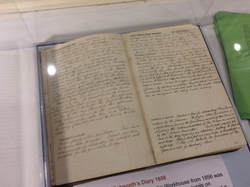
.John Payne's research for the exhibition turned up the 1856 diary of Mr William Winkworth, schoolmaster at Bath Union Workhouse. The diary records random child beatings and the frustrations of working in an institution, between the lines of terse statements a fascinating character emerges. An avid walker, he took the boys out on many local walks, by far the longest being the July 23 expedition around the parishes of Bath. An all day walk of something like 17 miles on a very hot day to the extent that he records "Haswell taken ill at Hampton left in charge of two boys was by some means taken to the Hospital. Several were over-tired and faint the heat being excessive."
The question remains as to why Winkworth led the boys out on this walk, was it to wear them out, was it to show them off? Perhaps they were wearing their new uniforms and he was showing them off to possible employers, distant relatives or the parishioners who were responsible for them. Or perhaps it was as a warning to the justaboutmanaging of what could befall them.
We walk in their footsteps, mindful of how even now in a wealthy city there are five of the poorest neighbourhoods in the country. Male life expectancy in Bath varies between 75 and 85. Hidden poverty. The project has thrown up a series of ironies around wealth, poverty and memorialisation. These informed the stopping points for the walk. Another old map show the Offices of the Poor Law Union strangely suspended above the then recently rediscovered Roman Baths....the cause of the hot floods in the basement and the City's greatest attraction.
...and then there are the two memorials in the Workhouse grounds to Eddie Cochran who died in what was then St Martin's Hospital following a car crash just outside Chippenham on 17 April 1960. The only person to die in the Workhouse building to get a memorial is not even buried there, Cochran's body was taken to California. Some say that the old corridors still echo to the Summertime Blues...
|
.On 23 July 1856, the boys from the Bath Workhouse, with their schoolmaster William Winkworth, completed a walk of 16 miles from the Workhouse around the parishes of Bath, returning via Bathampton Down. This was part of a series of regular walks Winkworth led.
The project coincides with the exhibition Dr John Payne has researched: Workhouse to Hospital. for The Museum of Bath at Work. The exhibition records the history of the Bath Union Workhouse at Odd Down, now the site of St Martin’s Hospital
The Workhouse bell is the centre piece of the exhibition, The bell, now silenced in a wooden block, once marked the hours of the day, the sound of an authoritative new time for those who had perhaps previously lived by the sun, moon, tide, body. The bell was released from its cask and recorded, its sound momentarily repatriated at the former workhouse and at points along the walks.
The exhibition also featured an assemblage by Lorna Brunstein based on a brief performance she gave at the Workhouse Burial Ground. Entitled, ' Such lovely earth to lie in' following a comment made by John Payne, who witnesssed Lorna's soil sampling at the Burial Ground. John has ancestors buried there.
The exhibition continues until the end of September
The Know Your Place West project has been invaluable in checking old maps and working out possible routes for the Workhouse Walks. The Workhouse Burial Ground is clearly indicated in a late C19 Ordnance Survey map, simply a bit of green space adjoining the St Martin's primary school field in the latest map of the area.
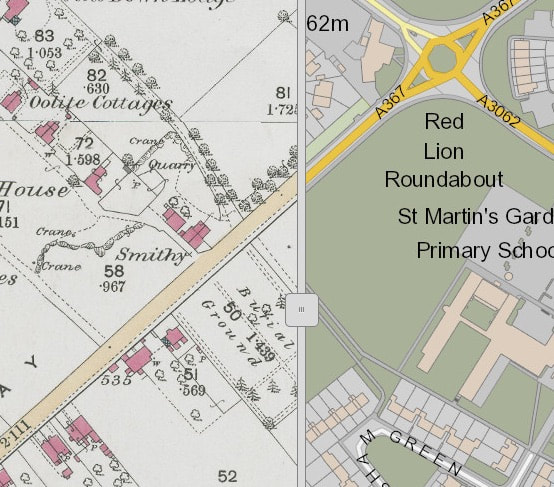
|
Forced Walks: Honouring Esther
Absence, presence and resonance on a Nazi death march transposed, returned and retraced. 2015-17
by the skin of our teeth from Richard White on Vimeo.
|
Honouring Esther.
A two year collaboration with artist Lorna Brunstein Honouring Esther transposed the route of a Nazi Death March to England and returned it to Germany. The walk in England was on rights of way following the line on the map as close as possible. The intersections between the walked route and the line on the map became stopping points, the stations of the walk. These were places for listening to testimony, readings, viewing photographs, points of reflection, sharing and resonance. The same cartographically defined stations were used on the walk in England in 2015 and the walk in Germany in 2016. Walkers were encouraged to share on social media, the walk was webcast live and a social media trail was generated. The original march was from a slave labour camp near Hanover into the death camp at Belsen. Richard devised a route through a landscape close to home based on the family and Imperial War Museum archive testimony of Esther Brunstein., Lorna's mother. This is an abstraction of processes Richard had previously used aimed at generating a networked experience of bearing witness in the context of a real physical walk. At each station the artists presented curated stimulus materials on a series of themes aimed at exploring contemporary resonances.
April 2015
The line of a Nazi Death March to Belsen transposed to Somerset. A 2 day walk as close as possible to that line. Where the walk intersects the line, interventions, 'stations' A performative walk-in-witness exploring resonances from the 70th anniversary of the liberation of Belsen. February 2016 The line of a Nazi Death March to Belsen transposed to Somerset. Returned to Germany. A 2 day walk on that line. Where the Somerset walk intersected the line, 'stations' A performative walk-in-witness exploring resonances from the 71stth anniversary of a Holocaust death march. February 2016 retracing the original death march route in Germany, seventy one years to the day after, Esther, and a group of Polish Jewish women undertook it.:
January 2017 Honouring Esther concluded with an exhibition in Bath showing new work and documentation from the project Supported by Bath Spa University,The Stephen Clark 1957 Charitable Trust, The Bristol - Hannover Association, Frome Town Council and private donors. Forced Walks is a programme of artist-led performative, socially engaged, public walks, digitally connected and mindful of those refugees, migrants, tramps, water-carriers and others who were/are forced to walk to survive. The programme seeks to reveal hidden stories of those dispossessed of land and home by war, economic and climate change and to generate contemporary and locative resonances. We walk at a time and to a place of our choosing in solidarity with those who had, or have, no choice. |
River Crouch Festival:
|
A commission to rediscover lost walks and hidden heritage in rural and coastal Rochford District evolved into a larger project celebrating the River Crouch. An 8 day 100 mile walk around the River Crouch linking schools and communities along the way took place in the summer of 2015
The Lost Walks of Rochford (2014) was a series of artist-led public walks rediscovering lost pathways, telling stories, gathering memories and and discussing local heritage. Ali Pretty and Richard White used old maps and word of mouth to build up routes; they discovered that some coastal paths had been washed out by the sea and some of the tracks along roads were lost to fast cars doing rat runs. In the coastal mud samphire was growing. These walks were well publicised and attracted a group of local walkers and a strong online following on twitter and facebook. A clear call to action and good online 'Mission Control' resulted in lively online exchanges as the walks progress. Ghost Crossings and the River Crouch celebrations took the project further exploring old and new ways of connecting across the water and prototyping a River Crouch Festival. The 2015 development saw schools twinned across the river working with local artists to produce a series of events connected by the walk, culminating in a feast day and celebratory river crossing. The long walk provides a narrative thread for the entire project. For more on that read 'Leaping the Crouch' below. facebook page Rochford District Council In collaboration with Ali Pretty. Commissioned by Rochford District Council
| ||||||||||||||||||
River Walk Bath
|
A commission to project manage student work for an installation at the opening of new studios at Bath Spa University. The walk offered thought provoking sights and sounds, revealing hidden histories around the designated theme of water:
Work and wealth. Leisure and decay. Flow and Still. The installation was based on and inspired by a walk from the historic water powered brass mill at Saltford along the river Avon, through the remains of Baths industrial heritage to a derelict Georgian lido. Saltford Brass Mill to Cleveland Pools along the river Avon. The C18 Brass Mill produced goods which were traded for slaves, the first users of the Lido would have been members of a community enjoying the wealth generated from the slave trade. The walk follows river and canal towpaths offering glimpses of luxury flats rising from the site of the old engineering works. |
Gravity Fields: Newton Walks
|
"A global social-media led adventure!" Tracing the walks Isaac Newton may have taken to school, visiting family, thinking about alchemy, religion and physics. Visiting iconic locations from the Newton story and stirring the myth-making pot. A commission from the arts and science festival Gravity Fields: creatively exploring the physical sciences and celebrating one of the world’s greatest thinkers, Sir Isaac Newton.
The recce was well supported and proved the case for a live and pro-active Mission Control: we will build on this with a strong visual presence devised by Ali Pretty and a developed live social media stream. The challenge is to connect with and engage the worldwide Newton community. The walks take place during the festival in September, in the build up Ali and Richard will be in residence delivering flag making and social media workshops. The digital work will continue to explore these three themes: · Historic Newton: traces of Newton in the town and landscape….what he might have seen, marks he might have left · Newton discoveries: local signs of Newton’s contribution to knowledge · Newton memorabilia: how Newton is remembered locally now...myths, icons, motifs In collaboration with Ali Pretty 2014 Commissioned by South Kesteven District Council with Arts Council and HLF funding |
Isle of Wight Carnival Trail Companion
|
An Arts Council funded commission via The New Carnival Company on the Isle of Wight to devise a new walking trail linking up the 9 carnival producing communities on the island. In collaboration with Ali Pretty and with local consultation Richard produced an interactive route covering approx 100 miles. Linking up with the local carnivals' social media streams the project was well supported, generating content used to populate the routes.
100 miles. 9 carnival towns. 5 days. 3-7 May 2014. Inaugurating a new long distance path celebrating more than 100 years of carnival on the Isle of Wight In a local residency Ali produced a series of flags for each Carnival community and Richard gathered sounds and other assets for the Carnival Trail Companion app. The live walking phase of the project was a tremendous success with each carnival community organising a welcome for the team of walkers. Mayors, town criers, carnival queens, samba bans and marching bands turned out to greet the walkers where the carnival flag for their community was presented. Some of the carnival associations are now using their flag to lead their annual procession The walk was inaugurated over five days in May 2014 and the app will be published later this year. The project demonstrated the value of linking social networking to a high profile outdoor public activity in drawing attention to and releasing forgotten social history and other elements of intangible cultural heritage. The project further confirmed the need for informed and pro-active 'Mission Control'. facebook page flickr feed In collaboration with Ali Pretty 2014 Commissioned by the New Carnival Company with Arts Council funding. |
Cranborne Chase AONB
|
A commission with Ali Pretty to gather local response, interpretations and stories from people who live, work or in some way use the Area of Outstanding Natural Beauty. The task was to provide text and visual elements for a forthcoming 5 year Management Plan.
Ali and Richard ran walking workshops with local people gathering stories, ideas and visual motifs, each one was focussed around a theme in the Management Plan. Strong views and clear ideas emerged demonstrating the value and efficacy of our approach. Sadly the work was caught up in cutbacks and although our collaborative text and artwork was completedthe publication was reduced to its formal text based essentials. Flickr stream In collaboration with Ali Pretty 2013 Commissioned by Cranborne Chase Area Of Outstanding Natural Beauty |
Walking Wessex White Horses
|
8 white horses, 5 days, more than 4000 years of human history. In the summer of 2013 three months of creative and outdoors activity culminated in a five day 100 mile walk through the Wiltshire landscape, going to each of the 8 Wiltshire White Horse and finishing at the Devizes Street Arts Festival. A heady mix of carnival, walking and social media. The project was subsequently developed with funding from the North Wessex Downs Area of Outstanding Natural Beauty to include the Uffington White Horse. At each White Horse the walkers raised a banner produced by Ali Pretty with local people and a sound park app Richard had devised working with sound and music sourced from sound artist around the world. A fully updated website for walkers was relaunched in February 2015 Sadly this too is now defunct along with the immersive audio experiences at each white horse. The walking routes remain on Richard's Outdooractive account
As well as hosting the live element, acting as an informal Mission Control, Wiltshire Museum hosted the installation, Freedom on My Doorstep. This brought together large silks by Ali, a series of short films and soundscapes produced by Richard and live links to the walks. “Eerie! Never walked, not a step, yet now transported alongside those walking” message in Freedom on My Doorstep visitors book August 2013 This was a prototype for the analogue/digital walking and social media arts project Ali and Richard have been proposing in the context of placemaking and outdoor arts activity. In collaboration with Ali Pretty 2013-15 Commissioned by the Wiltshire Museum with Arts Council support |
The Ridgeway Project
|
Thousands of years ago people walked the high hills of Wiltshire bringing new knowledge and new cultures from distant places; trading, migrating, fighting, making links and networks, they created a path which survives in places to this day. This project sought to bring together more new people and ideas, explore that ancient highway and its resonances as we establish and share a new set of links and connections on the web.
The commission involved a series of media gathering walks resulting in a social media stream, a website and a locative media app; this was showcased in an installation for the opening of the new County Hall in Trowbridge, Wiltshire. It was and continues to be an invitation to the community to explore both the county as a creative and dynamic place to live and the possibilities being opened up by the new facilities in County Hall. The starting point for this project is the set of iconic images produced by renowned photographer Fay Godwin held by the Creasey Museum in the Young Gallery, Salisbury Library. This set of prints was part of the collection Godwin created for the book: The Oldest Road: The Ridgeway, first published in 1975. Richard led on the project for Creative Wiltshire. 2012 Commissioned by Wiltshire Council |
